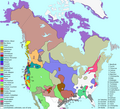File:Langs N.Amer.png
Vai alla navigazione
Vai alla ricerca

Dimensioni di questa anteprima: 661 × 600 pixel. Altre risoluzioni: 265 × 240 pixel | 529 × 480 pixel | 847 × 768 pixel | 1 129 × 1 024 pixel | 1 290 × 1 170 pixel.
File originale (1 290 × 1 170 pixel, dimensione del file: 599 KB, tipo MIME: image/png)
Cronologia del file
Fare clic su un gruppo data/ora per vedere il file come si presentava nel momento indicato.
| Data/Ora | Miniatura | Dimensioni | Utente | Commento | |
|---|---|---|---|---|---|
| attuale | 19:28, 20 lug 2019 |  | 1 290 × 1 170 (599 KB) | Denniss | Reverted to version as of 21:52, 1 March 2009 (UTC) |
| 18:54, 13 lug 2019 |  | 1 290 × 1 170 (840 KB) | Thylacinus cynocephalus | Having colonial borders on an indigenous language map is offensive | |
| 23:52, 1 mar 2009 |  | 1 290 × 1 170 (599 KB) | Malus Catulus | optipng, pngout | |
| 16:31, 22 dic 2006 |  | 1 290 × 1 170 (668 KB) | Mahahahaneapneap | pngcrushed | |
| 02:43, 11 nov 2006 |  | 1 290 × 1 170 (916 KB) | Ish ishwar | update | |
| 06:55, 1 apr 2006 |  | 1 296 × 1 176 (678 KB) | Locke Cole | smaller file (pngout /f0 Langs_N.Amer.png /b4096) / Change: -315546 bytes ( 68% of original) | |
| 06:01, 7 gen 2006 |  | 1 296 × 1 176 (986 KB) | Ish ishwar | adai,chimariko = unclassified; adjust uto-aztec, salinan, southern athabasc., muskogean; + Isla Ángel de la Guarda, Isla del Tiburón, Lake Okeechobee | |
| 23:24, 9 dic 2005 |  | 1 318 × 1 195 (714 KB) | Ish ishwar | checker grid pattern to Chumash | |
| 08:12, 6 dic 2005 |  | 1 318 × 1 195 (714 KB) | Ish ishwar | forgot seri, fix fam key | |
| 03:21, 6 dic 2005 |  | 1 318 × 1 195 (712 KB) | Ish ishwar | update |
Pagine che usano questo file
Le seguenti 2 pagine usano questo file:
Utilizzo globale del file
Anche i seguenti wiki usano questo file:
- Usato nelle seguenti pagine di af.wikipedia.org:
- Usato nelle seguenti pagine di an.wikipedia.org:
- Usato nelle seguenti pagine di ar.wikipedia.org:
- Usato nelle seguenti pagine di azb.wikipedia.org:
- Usato nelle seguenti pagine di az.wikipedia.org:
- Usato nelle seguenti pagine di bat-smg.wikipedia.org:
- Usato nelle seguenti pagine di be-tarask.wikipedia.org:
- Usato nelle seguenti pagine di beta.wikiversity.org:
- Usato nelle seguenti pagine di be.wikipedia.org:
- Usato nelle seguenti pagine di bg.wikipedia.org:
- Usato nelle seguenti pagine di br.wikipedia.org:
- Usato nelle seguenti pagine di ca.wikipedia.org:
- Usato nelle seguenti pagine di ca.wikimedia.org:
- Usato nelle seguenti pagine di cs.wikipedia.org:
- Usato nelle seguenti pagine di cv.wikipedia.org:
- Usato nelle seguenti pagine di da.wikipedia.org:
- Usato nelle seguenti pagine di da.wikibooks.org:
- Usato nelle seguenti pagine di de.wikipedia.org:
- Usato nelle seguenti pagine di dsb.wikipedia.org:
- Usato nelle seguenti pagine di en.wikipedia.org:
- History of the Americas
- North America
- Native Americans in the United States
- First Nations in Canada
- Linguistics and the Book of Mormon
- Lower Rio Grande Valley
- User:Ish ishwar
- Classification of the Indigenous languages of the Americas
- Wikipedia:Featured pictures thumbs/03
- Indigenous peoples of the Americas
- Wikipedia:Wikipedia Signpost/2005-12-26/Features and admins
- Wikipedia:Featured picture candidates/December-2005
- Wikipedia:Featured picture candidates/Indigenous language families north of Mexico
- User:Cyde/Featured pictures
- Talk:New World
- Wikipedia:Picture of the day/April 2006
- Wikipedia:POTD/April 1, 2006
- Wikipedia:Picture of the day/April 1, 2006
- Wikipedia:Today's second feature/April 1, 2006
- Portal:North America/Selected picture
- User talk:Wapcaplet/Archive 3
- Wikipedia:POTD column/April 1, 2006
- Wikipedia:POTD row/April 1, 2006
Visualizza l'utilizzo globale di questo file.


